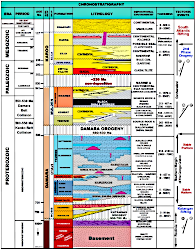Stratigraphy

The crust of the Earth is composed of solid rock, which is influenced by internal forces (plate tectonics) and external forces (atmosphere). The crust is covered by water and air, both decomposing and dissolving rocks in a process called weathering. But as those geologic processes are circles, nothing is added, nothing removed. The rocks are reduced to small pieces, gravel and then sand, which is sedimented and during a process called diagenesis again transformed into rock. Components which are solved by the water are precipitated, for example when the water evaporates. Or there are used by animals and plants to build shells or skeletons.
The result of those processes are so called sedimentary rocks, which are formed in stratas or layers.
So stratigraphy, a composition of strata and graphein, the Greek word for to draw, means to draw or otherwise record the different stratas.
So stratigraphy is the science of documenting stratified rocks, but also the science of earth history in terms of climate, as certain rocks and the way they were formed give us information about the climate at the time they were formed.
So there is a very close relation between stratigraphy and the
 Geologic Time Scale.
Geologic Time Scale.
Stratigraphy is very important for speleology, as only certain rocks are soluble and thus karstified. And virtually all of them are sediments: limestone, dolomite, gypsum and salt. So the structure of the strata, the thickness of the layers and the nature of the neighbouring stratas influence the formation of caves. Any caver should have a good idea about the distribution of the soluble rocks if he intends to discover new caves.
- See also
 Search DuckDuckGo for "Stratigraphy"
Search DuckDuckGo for "Stratigraphy" International Commission on Stratigraphy (ICS), a scientific body within the International Union of Geological Sciences (IUGS). Concerned with stratigraphy on a global scale.
International Commission on Stratigraphy (ICS), a scientific body within the International Union of Geological Sciences (IUGS). Concerned with stratigraphy on a global scale. An Online Guide to Sequence Stratigraphy from the University of Georgia’s Department of Geology and Stratigraphy Lab.
An Online Guide to Sequence Stratigraphy from the University of Georgia’s Department of Geology and Stratigraphy Lab. USC Sequence Stratigraphy gives an extensive overview on the topic.
USC Sequence Stratigraphy gives an extensive overview on the topic.

 Index
Index Topics
Topics Hierarchical
Hierarchical Countries
Countries Maps
Maps